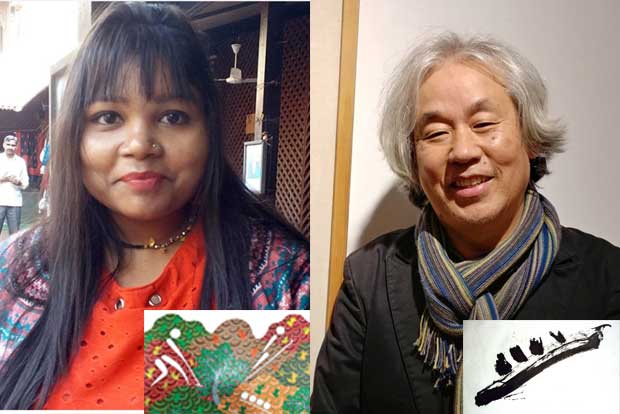Begin typing your search...
Confluence of Indian, Korean art
Japani Shyam, a noted Gond artist from Bhopal, and Song Dong Ock, a Korean calligraphist, are presenting a unique exhibition in the city, that coalesces traditional art forms from India and Korea, to commemorate the spirit of the Winter Olympics, a landmark event that opens in Korea, in February.

Chennai
Snowman – Imagining the Winter Olympics, an exhibition, curated by independent art curator, Insang Song based in Seoul, Korea, is an attempt to conceptually complement Gond painting and calligraphy, both centuries-old, finely nuanced traditional art forms from India and Korea, respectively. In the works that will be displayed, Japani Shyam and Song Dong Ock foreground the energy and vitality that epitomises the spirit of the Winter Olympics.
Speaking about how the collaboration materialised, Insang Song says, “We happened to meet Japani at the Crafts Museum in New Delhi, last year in January. We loved her work. She is one of the few Gond painting artistes who are keeping the artform alive. We met quite a few times in the last year and decided to collaborate for this venture. We felt her art would add a lot of life to our calligraphy works.”
For the uninitiated, Gond paintings are a form of folk and tribal art that is practiced by one of the largest tribes in India with whom it shares its name. Gond comes from the Dravidian expression, Kond which means ‘the green mountain’. While Gond paintings are largely found in Madhya Pradesh, it is also quite common in Andhra Pradesh, Maharashtra, Chhatisgarh and Odisha. According to the Gond belief system, every nature’s creation, be it a hill, river, rock or a tree, is inhabited by a spirit and, consequently, is sacred. The Gond people paint them as a form of respect and reverence and the paintings are a reflection of man’s close connection with his natural surroundings.
Daughter of the famous Gond artist Jangarh Singh Shyam, Japani’s art took a route different from that of her father’s. While the primary subjects of Jangarh’s paintings are Gond deities like Thakur Dev, Bada Deo, Kalsahin Devi and others, Japani’s world is inhabited by animals and rituals, and she integrates nature through forests which these animals dwell in. For Japani, this is the first time collaborating with an international artist. “I was never exposed to calligraphy until I met Insang and Song. Much like in Gond, in calligraphy, artists make sure to draw the inner as well as outer lines with as much care as possible so that the perfection of the lines has an immediate effect on the viewer. The lines are used in such a way that it conveys a sense of movement to the still images. Dots and dashes are added to impart a greater sense of movement and increase the amount of detail. This learning has opened a new world of opportunities for me. I hope to take our tribal artform to Korea this year,” muses Japani.
Song Dong Ock, who has joined hands with Japani, says, “The most fascinating part of Gond paintings is the use of bright vivid colours such as white, red, blue and yellow. Also, the fact that the paints are usually derived naturally from objects such as charcoal, coloured soil, plant sap, leaves and even cow dung, surprised me, pleasantly.”
Beyond art, Insang, who visited Chennai for the first time in 2006, has a fondness for the city’s culture and food. “I’ve been in love with this city for the last decade. In fact, it was the first city I visited in India. Apart from the dosa, sambhar and idli, I love the language here. In fact, Tamil and Korean have a lot of similarities. Amma and appa — denoting mother and father in the Korean language too — are among the first words Korean children learn. These are among the thousands of Tamil words that are part of the Korean language (Other Tamil words, among many others, found in Korean with the same meanings are: naal (day), pull (grass), pudhu (new), and sorru (rice)). So, in a way, we go back a long way. It feels at home here,” finishes Insang.
The exhibition is being presented by InKo Centre at their premises from January 20 to March 20.
Visit news.dtnext.in to explore our interactive epaper!
Download the DT Next app for more exciting features!
Click here for iOS
Click here for Android
Next Story



